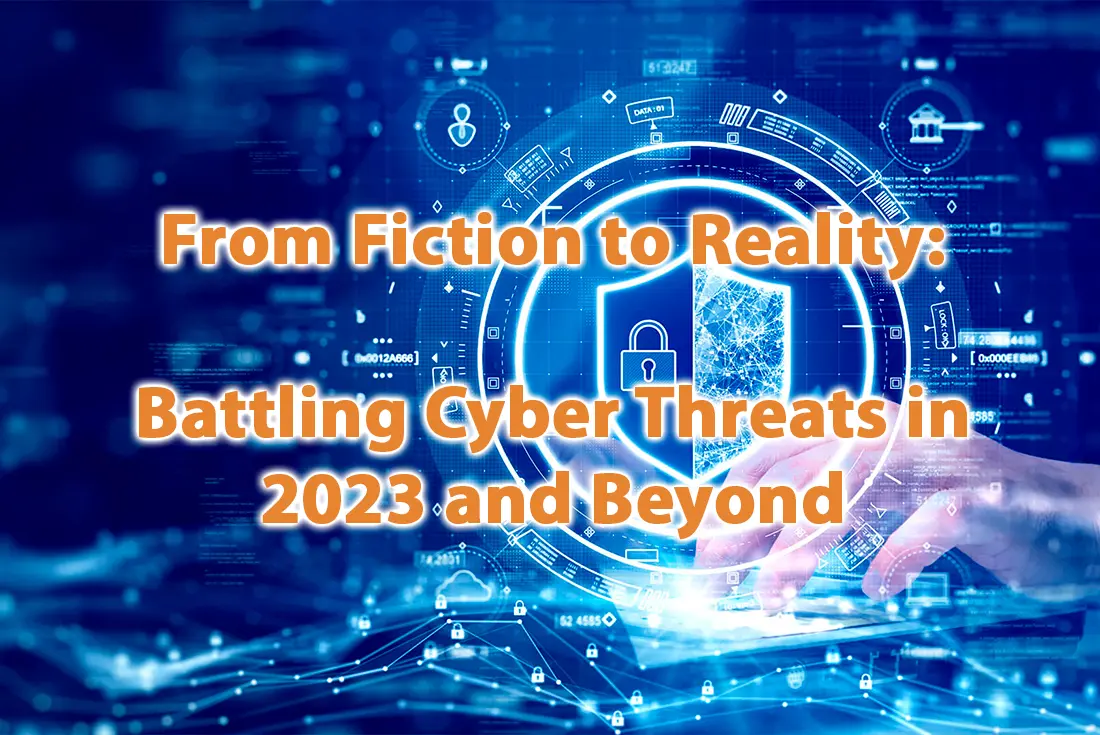
16 Nov From Fiction to Reality: Battling Cyber Threats in 2023 and Beyond
Cyber threats in 2023 are malicious actions aimed at infiltrating computer systems. They can cause loss of money, harm to reputation, disruptions in work, or even physical damage. Cyber threats aren’t new, but they’ve become more common and complex in our digital data-filled world where everything is connected. As technology gets better, so do the cyberattackers. That’s why it’s vital to understand how cyber threats have changed, what they’re like now, and what new trends are emerging. It’s also important to think about future strategies and challenges in fighting these threats. Keep reading to learn more!
Evolution of cyber threats
Cyber threats have a storied history, tracing their roots back to the dawn of computing and networking. Early examples include the 1988 Morris worm that infected thousands of computers, causing millions in damages, the ILOVEYOU virus of 2000 that spread via email attachments affecting millions globally, and the 2010 Stuxnet worm that targeted Iran’s nuclear program, destroying centrifuges. Over time, cyber threats have evolved, varying in techniques, motives, and targets.
Ransomware Surge: Ransomware encrypts victim’s data and demands a ransom for decryption. The frequency and sophistication of these attacks have increased, targeting not just businesses and individuals, but critical infrastructure and public services as well. For instance, in 2021, a ransomware attack on the Colonial Pipeline disrupted its operations and caused a fuel shortage.
State-Sponsored Cyberattacks: These are cyberattacks executed by or for a government for political, military, or economic purposes. They can involve espionage, sabotage, propaganda, or influence operations. In 2016, it was concluded that Russia interfered in the US presidential election by hacking and leaking emails from the Democratic National Committee and the Clinton campaign.
Cybercrime-as-a-Service: This involves professional hackers providing cyberattack tools and services to other criminals. It lowers the entry barriers and amplifies the scale and diversity of cyber threats in 2023. For example, in 2020, the DarkSide ransomware group offered its malware and infrastructure as a service to other hackers, who could then launch ransomware attacks and share profits with the group.
Facing cyber threats in 2023? Downtown Computer Services is here to support you. We safeguard your business from phishing, spyware, data breaches, and ransomware. To learn more about our services, call us at (954) 524 9002.
The Current State of Cyber threats in 2023
In 2023, cyber threats remain a daunting hurdle to digital security and stability. As per the World Economic Forum, cyberattacks rank among the top global risks based on likelihood and impact. Let’s have a look at some of the most rampant cyber threats in 2023, according to recent reports:
Phishing: This is a deceptive attempt to obtain sensitive information by posing as a trustworthy entity. It’s the most prevalent cyberattack method, contributing to over 80% of reported security incidents. Phishing attacks have become more sophisticated and targeted, using social engineering, spoofing, and AI to trick victims.
Data Breaches: These involve unauthorized access or theft of confidential data. Data breaches can expose personal, financial, or health information, or even an organization’s trade secrets or operational data. The repercussions can be severe, such as identity theft, fraud, or lawsuits. For instance, a massive data breach in 2022 exposed the personal information of over 700 million LinkedIn users.
Distributed Denial-of-Service (DDoS) Attacks: These are attempts to overwhelm or disrupt a website by flooding it with traffic or requests from multiple sources. DDoS attacks can lead to downtime, revenue loss, and reputational damage. They’ve grown in size and complexity, utilizing botnets, amplification techniques, or IoT devices. For example, Amazon Web Services, which hosts many popular websites, suffered a record-breaking DDoS attack in 2021 that peaked at 2.3 terabits per second.
Emerging Trends in Battling Cyber Threats
As cyber threats become more advanced and unrelenting, the ways we combat them have also evolved. Here’s how we’re stepping up our game against cyber threats in 2023:
Artificial Intelligence and Machine Learning: We use smart systems and algorithms to automate and enhance cybersecurity tasks. AI and ML can improve how we detect, prevent, and respond to cyber threats in 2023. They also boost the performance of cybersecurity systems. For instance, AI and ML can analyze huge data sets, find patterns and oddities, give alerts and suggestions, or learn from and adapt to new threats.
Blockchain Technology: It uses a distributed, decentralized, and unchangeable ledger to store and verify transactions or data. Blockchain can make different processes and applications more secure, transparent, and efficient. It can also reduce our need for third parties. For example, blockchain can help confirm the identity of users, devices, or services, protect data or assets, or allow peer-to-peer exchanges.
Teamwork between Governments and Organizations: Joint efforts or partnerships to share information, resources, or best practices to fight cyber threats in 2023. These collaborations can improve awareness, readiness, and resilience against cyber threats. They also encourage trust and cooperation. For instance, teamwork can help establish common standards, coordinate responses to incidents, or promote education or training.
Futuristic Measures to Combat Cyber Threats in 2023 and Beyond
As technology advances, new opportunities and challenges arise in cybersecurity. Let’s explore some cutting-edge approaches to combat cyber threats in 2023 and beyond:
Quantum Cryptography: This involves using quantum physics for secure communication, making it impossible for eavesdroppers to intercept undetected. Quantum cryptography offers a new level of security for encryption and key distribution and paves the way for new cryptographic protocols and applications. For instance, it can help implement quantum key distribution, which provides a secure solution to critical exchange problems.
Autonomous Cybersecurity Systems: These are self-learning, self-healing, and self-optimizing systems that perform cybersecurity tasks without human intervention. They can enhance the speed, accuracy, and scalability of cybersecurity operations, and handle the complexity and diversity of cyber threats. For example, they can monitor, analyze, and respond to cyber incidents or generate and update security policies and rules.
Ethical Hacking and Bug Bounty Programs: These programs involve authorized or incentivized hacking to test, identify, or fix vulnerabilities in systems or applications. They help enhance the security, quality, and performance of systems while also harnessing the skills and creativity of the hacker community. For instance, they can assist with penetration testing, vulnerability assessment, code review, or reward hackers for finding and reporting security flaws.
Challenges and Concerns in Addressing Cyber Threats
While we have several promising strategies to combat cyber threats, there are also numerous challenges and concerns.
Legal and Ethical Issues: These dilemmas emerge from the application or implementation of cybersecurity measures. They can involve matters such as jurisdiction, liability, and responsibility. For instance, issues arise from using offensive or defensive cyber operations, the attribution or prosecution of cyber attackers, or the regulation of cybersecurity activities.
Balancing Privacy with Security: Striking a balance between protecting personal information and ensuring security is a challenge. This involves tricky trade-offs such as data collection, storage, or sharing, or the use of surveillance technologies. For example, privacy concerns could arise from using biometric systems, access to personal or health records, or the encryption of communications.
Conclusion
Cyber threats are a pressing issue that impacts everyone in today’s digital era. They’ve become more diverse and sophisticated over time, with phishing, data breaches, and DDoS attacks being some of the most common threats in 2023. To counter these threats, a myriad of solutions have been developed, including AI and ML, blockchain technology, and quantum cryptography.
However, this field also presents challenges, such as legal and ethical dilemmas and privacy concerns. Hence, it’s crucial to stay informed about potential cyber threats and take proactive steps to protect your personal and professional life. This includes using robust passwords, regularly updating your software, backing up your data, and employing antivirus and firewall programs.
How to maintain a business in a world full of cyber threats? Trust your safety to Downtown Computer Services, a reliable computer support and services company. We can assist with any IT-related issues or requirements, from IT support and consulting to management and optimization. By partnering with us, you can stay ahead of the curve when it comes to cyber threats in 2023 and beyond. Call us at (954) 524 9002.
Check out other relevant news
- How Easy-to-Use Hacking Tools Are Fueling Cybercrime
- Cryptocurrency Security for Small Businesses: Protecting Your Wallet
- The Infostealer Epidemic: Protecting Your Business from the Latest Wave of Cyberattacks
- The Identity Crisis: How Compromised Credentials Can Cripple Your Business
- Beyond the Brick and Mortar: Building Your Online Storefront with Digital Marketing
